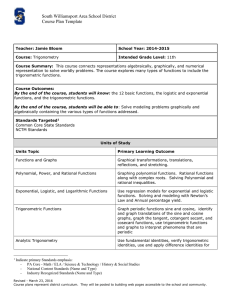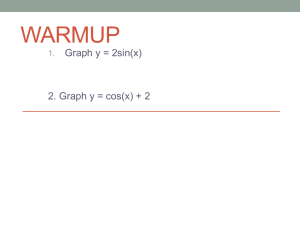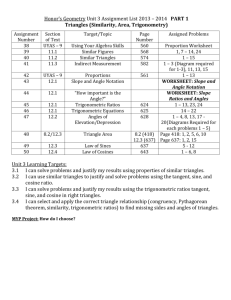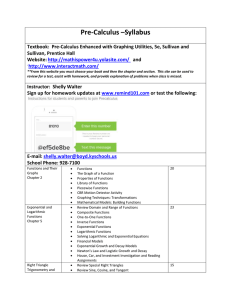math analysis a - cloudfront.net
advertisement
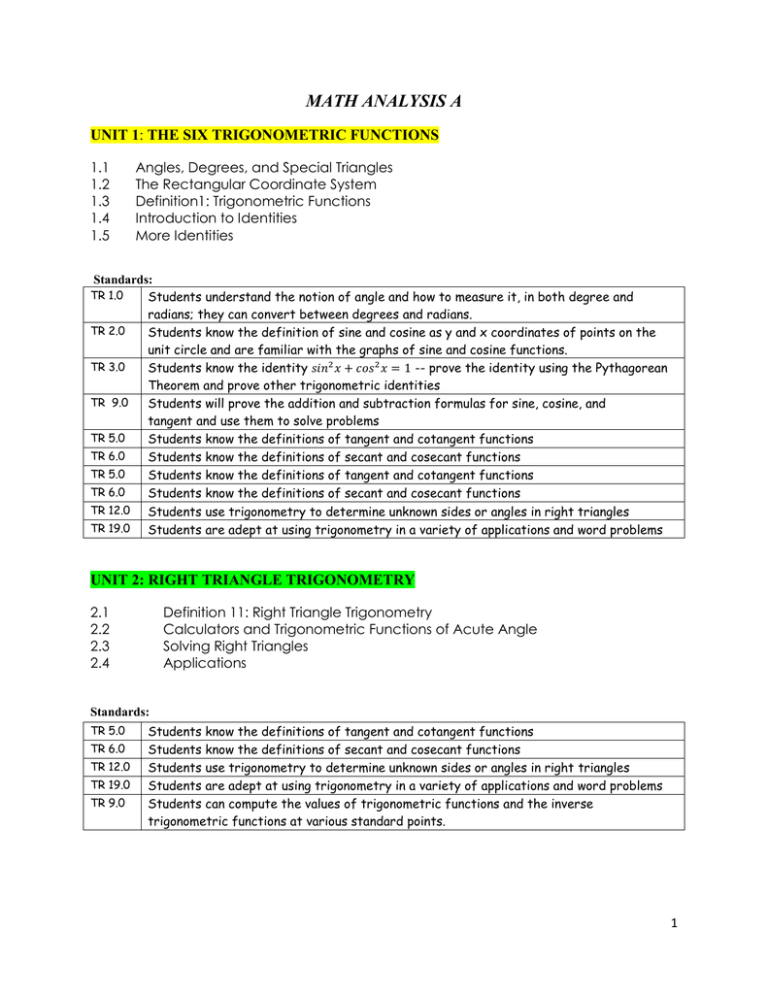
MATH ANALYSIS A UNIT 1: THE SIX TRIGONOMETRIC FUNCTIONS 1.1 1.2 1.3 1.4 1.5 Angles, Degrees, and Special Triangles The Rectangular Coordinate System Definition1: Trigonometric Functions Introduction to Identities More Identities Standards: Students understand the notion of angle and how to measure it, in both degree and radians; they can convert between degrees and radians. TR 2.0 Students know the definition of sine and cosine as y and x coordinates of points on the unit circle and are familiar with the graphs of sine and cosine functions. TR 3.0 Students know the identity 𝑠𝑖𝑛2 𝑥 + 𝑐𝑜𝑠 2 𝑥 = 1 -- prove the identity using the Pythagorean Theorem and prove other trigonometric identities TR 9.0 Students will prove the addition and subtraction formulas for sine, cosine, and tangent and use them to solve problems TR 5.0 Students know the definitions of tangent and cotangent functions TR 6.0 Students know the definitions of secant and cosecant functions TR 5.0 Students know the definitions of tangent and cotangent functions TR 6.0 Students know the definitions of secant and cosecant functions TR 12.0 Students use trigonometry to determine unknown sides or angles in right triangles TR 19.0 Students are adept at using trigonometry in a variety of applications and word problems TR 1.0 UNIT 2: RIGHT TRIANGLE TRIGONOMETRY 2.1 2.2 2.3 2.4 Definition 11: Right Triangle Trigonometry Calculators and Trigonometric Functions of Acute Angle Solving Right Triangles Applications Standards: TR 5.0 TR 6.0 TR 12.0 TR 19.0 TR 9.0 Students know the definitions of tangent and cotangent functions Students know the definitions of secant and cosecant functions Students use trigonometry to determine unknown sides or angles in right triangles Students are adept at using trigonometry in a variety of applications and word problems Students can compute the values of trigonometric functions and the inverse trigonometric functions at various standard points. 1 UNIT 3: RADIAN MEASURE 3.1 3.2 3.3 3.4 3.5 Reference Angle Radians and Degrees Definition III: Circular Functions Arc Length and Area of a Sector Velocities Standards: T-TF 1.0 T-TF 2.0 T-TFF 3.0 TR 1.0 TR 1.0 TR 2.0 TR 3.0 Understand radian measure of an angle as the length of the arc on the unit circle subtended by the angle. Explain how the unit circle in the coordinate plane enables the extension of trigonometric functions to all real numbers, interpreted as radian measures of angles traversed counterclockwise around the unit circle. (+) Use special triangles to determine geometrically the values of sine,cosine, tangent for π/3, π/4 and π/6, and use the unit circle to express the values of sine, cosine, and tangent for π–x, π+x, and 2π–x in terms of their values for x, where x is any real number. Students understand the notion of angle and how to measure it, in both degree and radians; they can convert between degrees and radians. Students understand the notion of angle and how to measure it, in both degree and radians; they can convert between degrees and radians. Students know the definition of sine and cosine as y and x coordinates of points on the unit circle and are familiar with the graphs of sine and cosine functions. Students know the identity 𝑠𝑖𝑛2 𝑥 + 𝑐𝑜𝑠 2 𝑥 = 1 -- prove the identity using the Pythagorean Theorem and prove other trigonometric `identities UNIT 4: GRAPHING AND INVERSE FUNCTIONS 4.1 4.2 4.3 4.4 4.5 4.6 Basic Graphs Amplitude and Period Phase Shift Finding and Equation from its Graph Graphing Combinations of Functions Inverse Trigonometric Functions Standards: TR 4.0 Students graph functions of the form 𝑓(𝑡) = 𝐴𝑠𝑖𝑛(𝐵𝑡 + 𝐶) or 𝑓(𝑡) = 𝐴𝑐𝑜𝑠(𝐵𝑡 + 𝐶) and interpret A, B, and C in terms of amplitude, frequency, period and phase shift. TR 5.0 Students know the definitions of tangent and cotangent functions TR 6.0 Students know the definitions of secant and cosecant functions TR 7.0 Students know that the tangent of the angle that a line makes with the x-axis is equal to the slope of the line. TR 8.0 Students know the definition of inverse trigonometric functions and can graph the functions. 2 UNIT 5: IDENTITIES AND FORMULAS 5.1 5.2 5.3 5.4 5.5 Proving Identities Sum and Difference Formulas Double-Angle Formulas Half-Angle Formulas Additional Formulas Standards: TR 9.0 TR 10.0 TR 11.0 TR 19.0 Students can compute the values of trigonometric functions and the inverse trigonometric functions at various standard points. Students demonstrate an understanding of the addition formulas for sines and cosines and their proofs and can use those formulas to prove and/or simplify other trigonometric identities Students demonstrate an understanding of half-angle and double-angle formulas for sines and cosines and can use those formulas to prove and/or simplify other trigonometric identities Students are adept at using trigonometry in a variety of applications and word problems UNIT 6: EQUATIONS 6.1 6.2 6.3 6.4 Solving Trigonometric Equations More on Trigonometric Equations Trigonometric Equations Involving Multiple Angles Parametric Equations and Further Graphing Standards: T-TF 7.0 MA 1.0 TR 9.0 TR 12.0 TR 19.0 Use inverse functions to solve trigonometric equations that arise in modeling contexts; evaluate the solutions using technology, and interpret them in terms of the context. interpret them in terms of the context.★ Students are familiar with, and can apply, polar coordinates and vectors in the plane. In particular, they can translate between polar and rectangular coordinates and can interpret polar coordinates and vectors graphically. Students can compute the values of trigonometric functions and the inverse trigonometric functions at various standard points. Students use trigonometry to determine unknown sides or angles in right triangles Students are adept at using trigonometry in a variety of applications and word problems 3 UNIT 7: TRIANGLES 7.1 7.2 7.3 7.4 7.5 The Law of Sines The Ambiguous Case The Law of Cosines The Area of a Triangle Vectors: An Algebraic Approach Standards: TR 13.0 TR 14.0 MA 1.0 LA 7.0 LA 12.0 Students know the Law of Sines and the Law of Cosines and apply those laws to solve problems. Students know the area of a triangle, given one angle and two adjacent sides. Students are familiar with, and can apply, polar coordinates and vectors in the plane. In particular, they can translate between polar and rectangular coordinates and can interpret polar coordinates and vectors graphically. Students demonstrate an understanding of the geometric interpretation of vectors and vector addition (by means of parallelograms) in the plane and in three dimensional space Students compute the scalar (dot) product of two vectors in n-dimensional space and know that perpendicular vectors have zero dot product Math Analysis A, Fall Semester 2013 4
